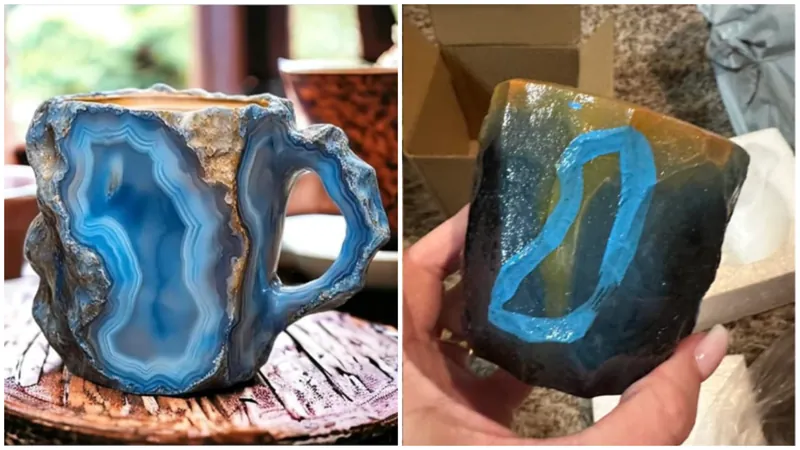
The Shocking Truth Behind AI-Generated Products: How to Spot the Scams!
2025-03-25
Author: Michael
Have you ever come across a strikingly beautiful product online that seemed too perfect to be real? You're not alone. As shopping increasingly shifts online, the rise of AI-generated images has created a landscape ripe for deception. This guide dives deep into identifying fake products, helping you navigate through the murky waters of e-commerce with confidence.
Imagine sipping coffee from a mug that looks like it's carved from rare minerals, shimmering with amethyst and quartz. Sounds enchanting, right? Unfortunately, many shoppers have fallen victim to such alluring advertisements, particularly for these so-called "crystal coffee mugs." These mugs appeared on multiple platforms like Facebook, Etsy, and even Amazon, stunning customers with their crystal-like appearance. However, when these excited buyers opened their packages, disappointment often followed.
In many cases, what was delivered bore little resemblance to the elegant images showcased in the listings. Instead of a luxurious gem of a mug, they received poorly made replicas that couldn't even pass as high-quality pottery.
The AI Challenge: Identifying the Red Flags
Thanks to significant advancements in AI technology, it’s becoming increasingly difficult to differentiate between genuine and artificially generated products. AI tools can produce convincing images, yet they sometimes reveal inconsistencies that can tip savvy shoppers off. Here are some red flags to look out for:
1. **Examine the Image Quality**: AI-generated images often have defects. If you notice that lines in the image don't align perfectly or there are smudges that look digitally added, that's a strong indicator of inauthenticity. 2. **Seek Multiple Angles**: Genuine listings typically include several images from different angles, allowing customers to evaluate the product comprehensively. If you only find a single dramatic photo, better hold your wallet – this could signify that the product is AI-generated. 3. **Read the Listing Carefully**: Sellers sometimes hide the fact that their images are AI-generated within the description. Look out for phrases like "crystal-like" that indicate the product may not match the image shown. 4. **Check Buyer Feedback**: Real customer reviews are crucial. Beware of listings without any, or that only have images that appear staged. Genuine customers typically post photos of their purchases, allowing you to compare the actual product with the listing. 5. **The Price Tag Dilemma**: Be cautious of deals that seem too good to be true. If you find a handcrafted item at a fraction of the expected cost, it’s wise to dig deeper. Price discrepancies can often indicate a scam. 6. **Investigate the Seller**: Know who you are buying from. Check their reputation, how long they’ve been selling, and explore their other products. A new seller with no track record raises a red flag.
The Need for Consumer Vigilance
The proliferation of AI-generated images is not limited to mugs; it extends to all kinds of products, including books and clothing. A troubling number of AI-generated books are finding their way onto platforms like Amazon and even into local libraries, often without any clear indication of their artificial origins.
For example, a recent scandal involved a cookbook written by an author named "Ethan Neulife," whose name yielded no results outside of Amazon listings. Further investigation revealed that even the author's profile picture appeared to be AI-generated, causing even more concern over the credibility of the publication.
How to Protect Yourself: Practical Tips
Before making an online purchase, take a moment to perform due diligence: - **Reverse Image Search**: This can help you identify whether the image has appeared elsewhere, potentially leading you to the original source or exposing it as a prior scam. - **Look for Seller Transparency**: Legitimate businesses pride themselves on their reputations. They provide detailed information about their products and welcome inquiries. - **Trust Your Gut**: If something feels off or too good to be true, don’t ignore that instinct. Trusting your intuition can help you avoid costly missteps.
As we venture further into a digital shopping age, knowledge is your best ally. By being vigilant and employing simple investigative techniques, you can safeguard yourself against the growing realm of AI-generated scams. Stay smart, and happy shopping!









 Brasil (PT)
Brasil (PT)
 Canada (EN)
Canada (EN)
 Chile (ES)
Chile (ES)
 Česko (CS)
Česko (CS)
 대한민국 (KO)
대한민국 (KO)
 España (ES)
España (ES)
 France (FR)
France (FR)
 Hong Kong (EN)
Hong Kong (EN)
 Italia (IT)
Italia (IT)
 日本 (JA)
日本 (JA)
 Magyarország (HU)
Magyarország (HU)
 Norge (NO)
Norge (NO)
 Polska (PL)
Polska (PL)
 Schweiz (DE)
Schweiz (DE)
 Singapore (EN)
Singapore (EN)
 Sverige (SV)
Sverige (SV)
 Suomi (FI)
Suomi (FI)
 Türkiye (TR)
Türkiye (TR)
 الإمارات العربية المتحدة (AR)
الإمارات العربية المتحدة (AR)